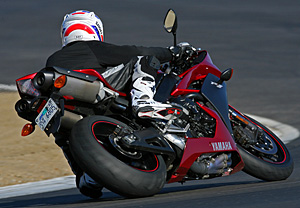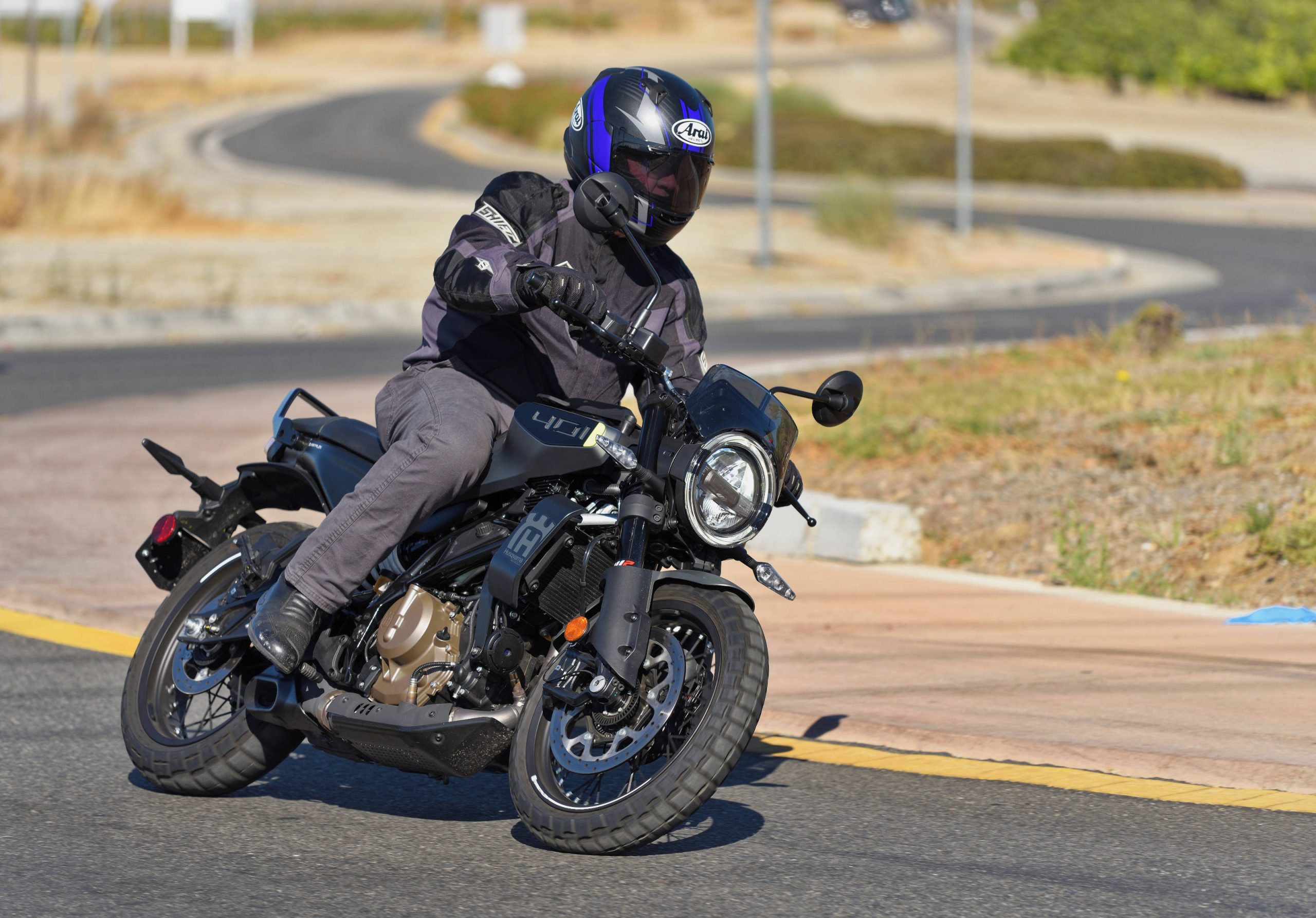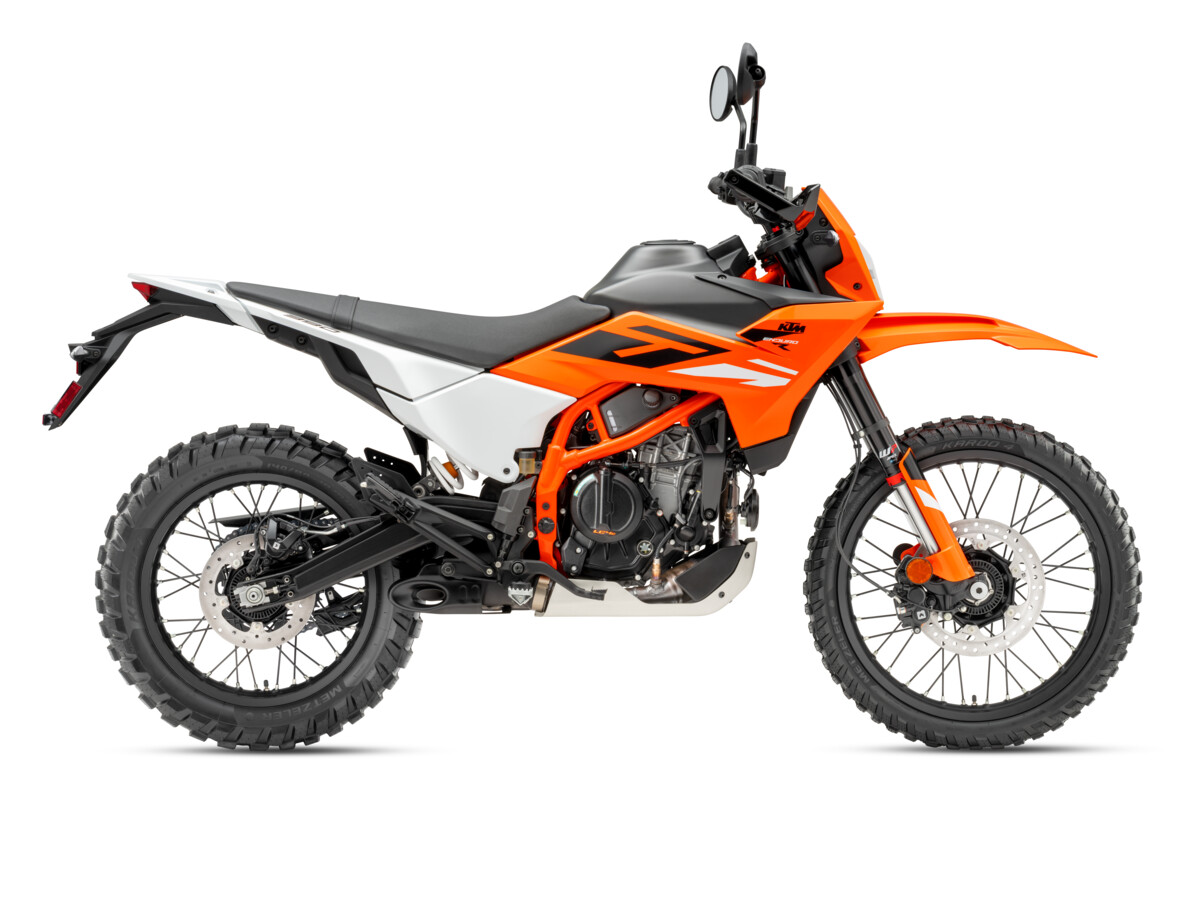
Since I wrote Part One of this impression on Saturday, I’ve had a few days to arrange my thoughts. After this period of contemplation, I feel I’m ready to put pen to paper (or, more accurately, fingers to keyboard) and share a more in-depth description of my riding experience last week at Laguna Seca.
A good starting point would be the motor, as this is where the 2007 R1 has received the most drastic changes, and where Yamaha’s engineers have made the greatest improvements over the previous model.
The 2005-2006 R1 was often criticized for having a powerband biased too heavily toward the top-end; the bike was a rocketship when the rider kept the needle in the upper quarter of the tachometer, but in the lower RPM range, it was out-powered by rivals like the Suzuki GSX-R1000 and Kawasaki ZX-10R. This “600-like” powerband was great on the racetrack, but in everyday street riding, the (relative) lack of low-end grunt and mid-range pull was disappointing.
As I discussed in Part One, the R1 design team was tasked with the seemingly contradictory goals of eliminating or mitigating these shortcomings, while at the same time significantly reducing the new bike’s emissions. To accomplish this, they decided to give up Yamaha’s traditional five-valve cylinder head design in favor of a more conventional four-valve layout, which allowed for a smaller combustion chamber and thus a higher compression ratio (now 12.7:1). The four throttle bodies feeding air to the new cylinder head are topped with an innovative system, called ‘YCC-I’, which varies the length of the intake runners depending on RPM and throttle position. Below 10,400rpm, the intake runners are 140mm in length, which significantly boosts low-end and mid-range power output. When the R1 spins past 10,400rpm (assuming the rider is applying at least 57.5% throttle), the upper section of the intake runners is lifted away, leaving the air to enter through the 65mm lower sections – a length optimized for high-rpm power output.

The throttle bodies also feature the same ‘YCC-T’ (Yamaha Chip Controlled Throttle) throttle by wire system that first debuted on the 2006 R6. Although the throttle is still connected to two cables which run down to the throttle bodies, these cables do not directly actuate the throttle body butterflies. Instead, the rider’s wrist motion is translated by a throttle position sensor, which tells the ECU how hard he wants to accelerate. The ECU then makes the decision as to how far and how quickly to open the butterflies, maintaining maximum air velocity in the intake tract to maintain maximum acceleration (consistent with the demands of the rider, that is). Why not locate the throttle position sensor directly on the twist throttle and eliminate the cables, you ask? Well, besides actuating the throttle position sensor, the return cable actuates a small arm that manually closes the throttle body butterflies. Thus, in the unlikely event of an electronic malfunction that left the butterflies open (the throttle-by-wire equivalent of a stuck throttle), the rider can manually close the butterflies by merely closing the throttle.
The changes I’ve gone over are the largest, but not the only new elements by any means. In fact, although the motor retains the same bore and stroke dimensions of the previous model, the internals are basically all-new. Obviously the cylinder head and ports were significantly redesigned to accommodate the change from five valves to four, and the intake valves themselves actually have a somewhat smaller overall area. The camshafts are entirely redesigned as well, and the intake cam lifts the valves higher than last year to compensate for the smaller valve area. The exhaust is also all-new, featuring two catalytic converters for emissions compliance. To compensate for the increased weight of the converters, the rest of the exhaust system is constructed primarily from titanium for light weight.
Out on the track, the results of all this engineering are immediately apparent. The new engine responds crisply from as low as 3,000rpm, and although the racetrack doesn’t offer much chance to evaluate the low-end (other than the pit lane), my first impression was that there has been a significant improvement here over the previous bike. A more thorough analysis will have to wait until we swing a leg over a new R1 for in-depth street testing (which will hopefully happen very soon!).

Although I didn’t spend much time in the low-end, Laguna Seca did offer me a perfect opportunity to test Yamaha’s claim of greatly increased mid-range power. The track’s final corner, Turn 11, is a tight, flat left-hander that exits onto the long front straightaway. I wasn’t able to carry much corner speed through 11, and consequently found myself exiting the corner at around 7,000rpm in first gear. The R1 accelerated crisply and with authority from this point, and despite keeping my weight as far forward as possible, I was unable to keep the front wheel in contact with the tarmac in first gear, or in the beginning of second. Unlike the previous generation R1, the new bike didn’t need time to ‘hit its stride’ – acceleration was instantaneous and linear, starting out strong and building progressively as the needle spun from 7,000rpm toward redline. Although it’s impossible to say without making a direct (back-to-back) comparison, I suspect that the new R1’s mid-range power will be competitive with that of the other bikes in its class, and it still has that vicious top-end acceleration (now with a claimed 5 peak horsepower more than last year’s model).
I should mention that while the exit of Turn 11 highlighted the R1’s accelerative abilities, the rest of the corner was a showcase for the excellence of the YCC-T system. I’ve never particularly liked going down to first gear for a corner on the track, as the shorter gearing magnifies the consequences of any instability in the rider’s throttle hand. With the light weight and huge torque of a 1000cc sportbike, this can be seriously dangerous – a lack of smoothness when picking up the throttle on the exit, or a slight wiggle of the wrist mid-corner, can be all it takes to join leather and tarmac.
Much as I would have loved to take Turn 11 in second gear, I just wasn’t carrying enough corner speed, and I would have been left to exit the corner with the motor revving barely above idle. Imagine my surprise, then, when I found the R1 to be a willing partner that helped me carve a smooth arc with no hint of jerking. The YCC-T is so smooth, it almost seems that it cushions any slight wiggles the rider accidentally makes, while at the same time never seeming anything less than direct or natural while accelerating. Indeed, even more help managing the new R1’s impressive output comes in the form of a dual-mode ECU that uses a separate ignition timing map for first and second gear, smoothing out the power delivery.

Another welcome addition to the new R1 is the ramp-type slipper clutch. In the few years since slipper clutches started to become commonplace on production sportbikes, I’ve become a firm believer in their usefulness. The slipper clutch gave me more confidence when braking late into Turn 2, where I had to scrub off the 140+mph I’d gathered on the front straightaway. This single feature makes a huge difference when riding on a track (not to mention aggressive street riding), and I look forward to the day when every sportbike sold leaves the factory similarly equipped.
So we know that the new motor is good, but what about the chassis? Honestly, after riding the 2006 R6 and experiencing its incredible chassis and suspension, I was expecting big things from the R1 in this department, and it didn’t disappoint. While I would hesitate to say that the new R1 is as big a leap forward for its class as the R6 was in 2006, the new chassis and suspension are definitely impressive.
With the 2007 R1, Yamaha has fully embraced the concept of ‘tuned flex’ – that is, the idea that, because a sportbike at a large lean angle is not making effective use of its suspension (the forces are coming in at the wrong angle), building a chassis that allows a certain amount of flex in some directions, while remaining rigid in others, can create a bike that has better feel and traction, and more consistent at-the-limit behavior.
After careful study of the forces involved, the R1’s design team ended up reducing the rigidity of the 2007 frame in every direction when compared to the 2006 bike. The swingarm is more rigid torsionally, but more flexible laterally, and is 16mm longer than the previous model. All this is claimed to give better traction and ‘feel’ at both ends of the bike, and in every part of the corner. The revised front end geometry, which sees fork offset reduced from 30mm to 25mm while trail is increased from 97mm to 102mm, is also claimed to help give a “more precise and responsive front end, with improved feedback.”

Damping is provided by new, fully adjustable 43mm KYB forks up front, which feature larger diameter pistons (claimed to improve damping) as well as slightly stiffer springs. Out back, the Soqi shock is similar to the one fitted to the 2006 R6, featuring a stiffer spring, separate high- and low-speed compression damping, and of course rebound damping along with a stepped adjustable preload collar.
I really don’t know enough about the application of forces to a motorcycle chassis during cornering to form an educated opinion on the validity of the entire ‘tuned flex’ theory, and whether it is a recently discovered (I first recall it being mentioned a few years ago, in relation to MotoGP prototypes) stroke of brilliance, or simply the latest trend. But the proof, as they say, is in the pudding, and since I don’t want to continue that analogy for fear of confusing our more literal-minded readers, let’s just say the new R1’s chassis works pretty damn well.
After my initial track session, I came in feeling like the bike was set up too stiff for my weight (~140lbs) – a common complaint for me, as it seems most modern sportbikes are targeted at riders weighing around 170lbs. Changes were limited to reducing the preload both front and rear, and the R1 immediately became a comfortable companion. In the past, I’ve often found liter bikes to be somewhat intimidating, with their extra weight and increased power compared to a 600. In fact, I often felt that I was lapping faster on a 600, and definitely more confidently. The new R1, however, is a bike that immediately inspired my complete confidence. Although it doesn’t turn quite as well as a 600 (a bike with a 190-width rear tire is unlikely to ever turn like one with a 180), it comes close enough to feel irrelevant. Although the bike has gained a small amount of weight since last year, it doesn’t feel it, and it easily handled the rapid left-to-right transition as I dropped into Laguna Seca’s famous Corkscrew.

Feedback from both ends is excellent, but the front end truly stands out in terms of offering exemplary feel and confidence. As the day wore on, I continued to push harder, and the front end always felt like it wanted more. The Pirelli Diablo Corsas contributed to the excellent feedback, and provided an impressive combination of quick warm-up, grip, and durability. I left the track at lunchtime, but at that point the tires on my test bike looked like they could have taken the rest of the day’s abuse and gone back to the street with little problem.
The new six-piston front calipers provide massive stopping power. I never felt like I was approaching their limits. A radial master cylinder, similar to that fitted to the R6, provides excellent feel and progressive brake application, and one finger was all that was necessary for the level of braking I was using.
In the focused environment of the racetrack, it’s difficult to pay attention to comfort, but the new R1 clearly has an aggressive riding position. Although the bars are placed low, they’re not too far away, and my upper body position was comfortable enough. The footpegs, on the other hand, are fairly high, and while it didn’t bother me (I’m 5’9″ tall, and used to riding sportbikes), a taller rider or one coming from a less aggressive machine might find it uncomfortable. The higher pegs increase ground clearance, of course. With the peg feelers removed, I never touched the pegs down all day, despite using some pretty aggressive lean angles (for me). For track day enthusiasts or aggressive canyon riders, this could save you the cost of rearsets.
Yamaha has kept the iconic front-end styling, while updating the aerodynamics and increasing the efficiency of the ram-air ducts. From the side, the fairing looks similar to the 2006 R6, with prominent ‘winglets’ and large exit slots to extract hot air. The sharp-edged tailsection and restyled dual mufflers are again evolutionary rather than revolutionary, which is probably a good thing, considering that the previous-generation R1 was almost universally acclaimed for its styling.

In the end, Yamaha have managed to build a bike that is improved in every area over its predecessor. The 2007 R1 is better on the track, thanks to sharper handling, better suspension, and more power; it will likely be better on the street as well, with a broader spread of power and a much more impressive midrange punch. At the same time, it is one of the easiest liter bikes in the world to ride fast, one that fills its rider with confidence and constantly keeps him informed about the activity at each contact patch. Most important for me on this day, it immediately put me at ease on a track I had long revered, but never ridden. What more can I say?





